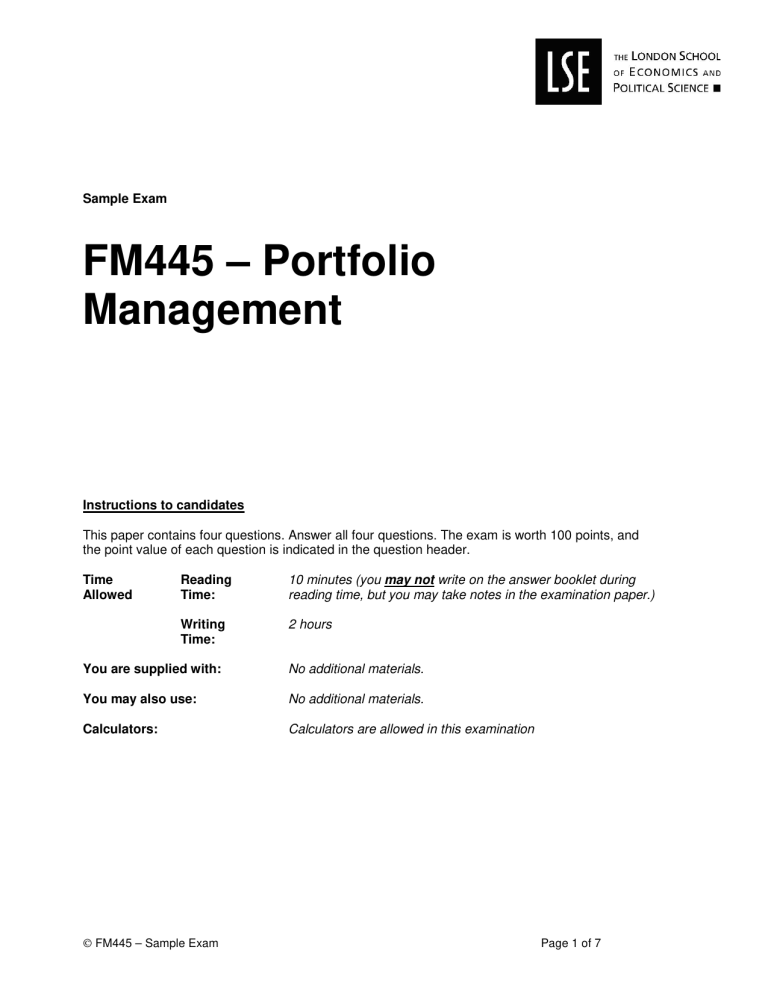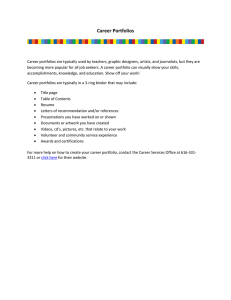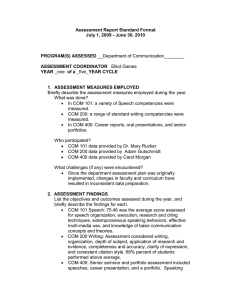
Sample Exam FM445 – Portfolio Management Instructions to candidates This paper contains four questions. Answer all four questions. The exam is worth 100 points, and the point value of each question is indicated in the question header. Time Allowed Reading Time: 10 minutes (you may not write on the answer booklet during reading time, but you may take notes in the examination paper.) Writing Time: 2 hours You are supplied with: No additional materials. You may also use: No additional materials. Calculators: Calculators are allowed in this examination FM445 – Sample Exam Page 1 of 7 Question 1: Dynamic Investment Strategies [25 Points] A recent paper re-examines the profitability of size, value, and momentum strategies extending the analysis to more recent sample periods. One of the goals of the paper is to investigate the separate contribution of long and short portfolios to the profits of each strategy. The following table shows average raw returns in excess of the one-month T-bill rate, Sharpe ratios, and CAPM alphas of value-weighted decile portfolios formed on size, value (book-to-market), and momentum (past 12-month returns), as well as the difference between Deciles 10 and 1 (10-1). The returns are averaged over the period July 1926 to December 2011. t-statistics are shown in parentheses. Returns and alphas are obtained monthly and reported as annualized percentages. a. [9 points] Explain how you would implement size, value, and momentum strategies to replicate this table (assume monthly rebalancing of the portfolios). b. [8 points] Describe the results presented in the table. Are these strategies profiting more from long or short positions? c. [8 points] Consider the interaction between size and momentum strategies. The following table is based on 25 portfolios obtained from the intersection of size-momentum quintile portfolios. The table reports profits measured in excess returns and in alphas. In particular, for these two measures, the table reports: the return spread between high and low momentum portfolios (5-1) for each size quintile; the profits of the long side of the strategy; the percentage of the profits coming from the long side (including a t-statistic for whether the profits from the long side are the same as the profits from the short side). Interpret the results in the table. FM445 – Sample Exam Page 2 of 7 FM445 – Sample Exam Page 3 of 7 Question 2: APT and Performance Evaluation [30 Points] [The following information applies to items (a) and (b).] The returns on assets in an economy depend on the realization of two risk factors, denoted by and . Three welldiversified portfolios (denoted by A, B and C) are available whose returns are given by the following expressions: = 0.06 + −2 = 0.05 + 2 − = 0.05 + 3 + As in the lecture notes, we assume that = = 0. a. [15 Points] Use assets A, B and C to construct factor-replicating portfolios for factor 1, factor 2 and for the risk-free asset in this economy. Show your step-by-step calculations. Express the APT equation in this economy. b. [5 Points] A fourth asset, denoted by D, is introduced in this economy. Its returns are given by = 0.05 + +3 Are there any arbitrage opportunities in the economy with assets A, B, C and D? Explain. If such an arbitrage opportunity exists, explain in detail how you would implement it assuming that only assets A, B, C and D can be traded (that is, you cannot trade the portfolios you constructed in item a. directly.) c. Assume that you are currently managing a portfolio that is replicating the market index. You identify a new portfolio P1 of stocks which, over the past five years, has produced a monthly CAPM alpha of 0.0105, has a beta of 0.8185, and a monthly standard deviation of excess returns of 0.0282. The market excess return over the same period is 0.0137 and its volatility is 0.0305. i. [5 Points] You decide to combine portfolio P1 with the market portfolio in an optimal manner. What is the Sharpe ratio of this new portfolio of stocks? What does this measure indicate? Explain. ii. [5 Points] In addition to portfolio P1, you have portfolio P2 available, with market beta 1.1, monthly CAPM alpha of 0.0083 and monthly standard deviation of excess returns of 0.031. When combining portfolios P1 and P2 optimally with the market portfolio, what is the Sharpe ratio of the resulting portfolio? FM445 – Sample Exam Page 4 of 7 Question 3: Dynamic Investment Strategies and Performance Attribution [25 Points] a. [10 points] A research paper tries to understand the investment strategy that is responsible for the remarkable performance of Warren Buffett by examining the returns of Berkshire Hathaway. The table below shows estimates of alphas and slope coefficients using two models: (i) the four-factor model (Carhart), and (ii) a model that adds the Betting-Against-Beta factor (BAB). These two models are estimated for the actual returns of Berkshire Hathaway stock, and for a replicating portfolio that uses Berkshire’s publicly traded equities as reported in its disclosures of holdings at the end of each quarter. Alphas are annualized and expressed in percent (t-statistics are shown in parentheses). b. [7 points] Define and explain the meaning of the three measures of performance attribution: Characteristic Selectivity, Characteristic Timing, and Average Style. c. [8 points] The following graph shows average estimated alphas for ten portfolios of hedge funds that are sorted each month on their liquidity beta. The liquidity beta is calculated each month from a regression of hedge fund returns on the market return and a liquidity factor, using data over the prior 24 months. FM445 – Sample Exam Page 5 of 7 The bars represent the monthly alphas of the ten liquidity-beta portfolios, estimated using the following factors: the market risk premium, SMB of Fama and French (1993), the spread in returns between long and short-term Treasury bonds, the spread in returns between Corporate and Treasury bonds, and three trend-following factors (returns on lookback straddles for bonds, currencies, and commodities). The circles represent the tstatistics of the alphas. The figure also displays the alpha of the high-minus-low liquiditybeta portfolio (High-Low). Assume that the liquidity factor used to compute liquidity betas is the Pastor-Stambaugh factor that we studied in the course. What do these liquidity betas represent? Interpret the results of this test. FM445 – Sample Exam Page 6 of 7 Question 4: Portfolio Optimizations and Black-Litterman [20 Points] You want to allocate your investment optimally among five equity portfolios and the risk-free asset. The equity portfolios are: domestic equities with high past returns (winners), domestic equities with low past returns (losers), domestic equities with high book-to-market (value), domestic equities with low book-tomarket (growth), and a portfolio of international equities. The following table shows the proportion of market value (w) represented by each asset. a. [7 Points] In the context of the Black-Litterman model, you expect winners to outperform losers by 0.8% per month, based on your estimates of a momentum strategy that you have recently implemented. You also expect the return of growth stocks (in excess of the risk free rate) to be 0.5% per month, based on the consensus of financial analysts. Set up the investor optimization problem, specifying the matrix P and the vector Q for your views. How can you specify the matrix Ω of uncertainty about your views? Assume that you are more certain about your expectation on winners vs. losers than about your expectation on growth stocks. Explain how you would compute the new vector of expected returns. Finally, explain how you would obtain the optimal Black-Litterman weights for your asset allocation. b. [7 Points] After implementing the BL model using a coefficient of risk aversion λ=1 and a parameter τ=0.05, you obtain the following vector of optimal BL weights: w* = [61.5% -23.3% 18.9% 32.5% 20.8%] Compute and discuss the differences in weights between the case in which you express no views on the five assets and the new BL weights w* obtained using your subjective expectations. c. [6 Points] Assume now that, besides the views described in the table above, you expect international stocks to outperform value stocks by 0.3% per month. How would P and Q change? What impact do you expect this view to have on the optimal weights? FM445 – Sample Exam Page 7 of 7

